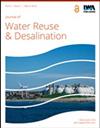核桃壳和纳米二氧化钛改性污泥基活性炭去除水溶液中阿莫西林的研究
IF 2.3
Q2 Environmental Science
引用次数: 7
摘要
以脱水城市污泥为原料制备活性炭(SAC),并用核桃壳和纳米二氧化钛(MSAC)对其进行改性。结果表明,MSAC比SAC具有更高的比表面积(SBET)(279.147m/g)和总孔体积(VT)(0.324cm/g)。同时,MSAC表面的C-O、C1⁄4O和Ti-O-Ti等官能团由于改性而增强。这些物理化学性质为污染物在MSAC中的扩散和降解提供了先决条件。此外,应用MSAC从水溶液中吸附阿莫西林(AMX),在分批实验中,在AMX初始浓度为30mg/L、MSAC剂量为5.0g/L、pH为8、接触时间为180min和温度为25℃时,观察到最大去除率(88.19%)。此外,Freundlich等温线模型和拟二阶动力学模型很好地描述了吸附过程,表明AMX在MSAC上的吸附以多层化学吸附为主。吸附热力学表明,AMX在MSAC上的吸附过程是吸热的、可行的和自发的。本文章由计算机程序翻译,如有差异,请以英文原文为准。
Removal of amoxicillin from aqueous solution using sludge-based activated carbon modified by walnut shell and nano-titanium dioxide
Dewatered municipal sludge was used as raw material to prepare activated carbon (SAC), and the SAC was modified by walnut shell and nano-titanium dioxide (MSAC). The results showed that the MSAC had a higher specific surface area (SBET) (279.147 m /g) and total pore volume (VT) (0.324 cm /g) than the SAC. Simultaneously, the functional groups such as C-O, C1⁄4O, and Ti-O-Ti on the surface of MSAC were enhanced due to modification. These physicochemical properties provided prerequisites for the diffusion and degradation of pollutants in MSAC. Furthermore, the MSAC was applied to adsorb amoxicillin (AMX) from aqueous solution, in batch experiments, the maximum removal rate (88.19%) was observed at an initial AMX concentration of 30 mg/L, MSAC dosage of 5.0 g/L, pH of 8, contact time of 180 min, and temperature of 25 C. In addition, the adsorption process was well described by the Freundlich isotherm model and pseudo-second-order kinetic model, indicating that the adsorption of AMX onto MSAC was dominated by multilayer chemisorption. Also, the adsorption thermodynamics suggested that the adsorption process of AMX onto MSAC was endothermic, feasible and spontaneous.
求助全文
通过发布文献求助,成功后即可免费获取论文全文。
去求助
来源期刊

Journal of Water Reuse and Desalination
ENGINEERING, ENVIRONMENTAL-WATER RESOURCES
CiteScore
4.30
自引率
0.00%
发文量
23
审稿时长
16 weeks
期刊介绍:
Journal of Water Reuse and Desalination publishes refereed review articles, theoretical and experimental research papers, new findings and issues of unplanned and planned reuse. The journal welcomes contributions from developing and developed countries.
 求助内容:
求助内容: 应助结果提醒方式:
应助结果提醒方式:


